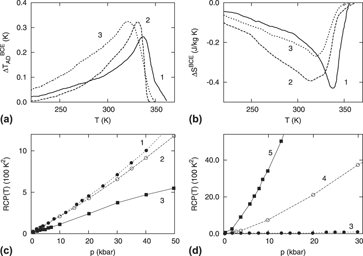Article contents
Caloric effects and phase transitions in ferromagnetic–ferroelectric composites xLa0.7Pb0.3MnO3–(1−x)PbTiO3
Published online by Cambridge University Press: 13 December 2013
Abstract

Ceramic volumetric composites xLa0.7Pb0.3MnO3–(1−x)PbTiO3 (x = 0.18 and 0.85) were prepared. X-ray investigations have shown that rather low sintering temperature (800 °C) has allowed us to avoid the reaction and interdiffusion between two initial phases. Heat capacity, thermal expansion, and intensive magnetocaloric effect were measured in a wide temperature range. The sample composition has a low influence on temperatures of the ferromagnetic and ferroelectric phase transitions in composites. Electro- and barocaloric effects were determined by analysis in the framework of thermodynamic theory, electric equation of state, Maxwell relationships, and entropy–temperature–pressure phase diagram. Multicaloric efficiency of composites is discussed and compared with that of initial La0.7Pb0.3MnO3 and PbTiO3 compounds. Variation of a relationship between components can significantly increase both barocaloric and magnetocaloric efficiency of compositional material due to the mechanical stress appearing between grains of different ferroic phases under magnetic field.
Keywords
- Type
- Articles
- Information
- Copyright
- Copyright © Materials Research Society 2013
References
REFERENCES
- 8
- Cited by




